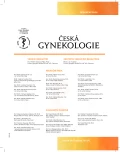Isolated fetal ascites
Authors:
M. Kuniaková 1; T. Binder 1; M. Pánek 2
Authors‘ workplace:
Gynekologicko-porodnická klinika Masarykovy nemocnice, Ústí nad Labem, přednosta doc. MUDr. T. Binder, CSc.
1; Neonatologická klinika, Masarykova nemocnice, Ústí nad Labem, přednosta MUDr. P. Hitka, Ph. D.
2
Published in:
Ceska Gynekol 2019; 84(6): 435-438
Category:
Case Report
Overview
Objective: We present a rather rare case of isolated fetal ascites. We summarize its possible causes and diferential diagnostic procedure, our pregnancy managment and final outcome of the child.
Study design: Case report.
Settings: Gynekologicko-porodnická klinika, Masarykova nemocnice, Ústí nad Labem; Neonatologická klinika, Masarykova nemocnice, Ústí nad Labem.
Methods: The pacient 18-years-old, I/0, was admitted to our clinic in the 32nd week of pregnancy with the diagnosis of significant isolated fetal ascites. Gradually, the most common causes of isolated ascites were excluded by the examination algorithm: developmental defects of GIT, urogenital tract and heart defects, genetic disorders, metabolic defects and immune and nonimmune causes of fetal hydrops. During the hospitalization, ascites lightening puncture was performed twice because of the significant lung tissue compression – without significant long-term effect. At the gestational age of 33+4, caesarean delivery was indicated for extreme ascites growth and significant lung tissue relapse. A boy of 2150 g with a serious respiratory distress was born. Immediately after delivery in the operating theatre a relieving ascites puncture was performed and the ventilation parameters improved immediately thereafter. During the following hospitalization the ascites has spontaneously, completely and definitely resorbed. The newborn was released into home care 49 days after delivery.
Conclusion: Idiopatic isolated fetal ascites is a relatively rare diagnosis with a favourable outcome. The etiology of ascites could not be identified.
Keywords:
fetal ascites – isolated
Sources
1. Agrawala, G. Isolated fetal ascites caused by bowel perforation due to colonic atresia. J Maternal-Fetal Neonatal Med, 2005(4), 4. doi: 10.1080/14767050500133516.
2. Catania, VD., Muru, A. Isolated fetal ascites, neonatal outcome in 51 cases observed in a Tertiary Referral Center. Eur J Pediat Surg, 2017(1), 7. doi: 10.1055/s-0036-1597269.
3. El Bishry, G. The outcome of isolated fetal ascites. Eur J Obstet Gynecol Reprod Biol, 2008(1), 4. doi: https://doi.org/10.1016/j.ejogrb.2007.05.007.
4. Favre, R., Dreux, S. Nonimmune fetal ascites: A series of 79 cases. Am J Obstet Gynecol, 2003(2), 6. doi: https://doi.org/10.1016/j.ajog.2003.09.016.
5. Nose, S. The prognostic factors and the outcome of primary isolated fetal ascites. Pediat Surg Internat, 2011(8), 6. doi: 10.1007/s00383-011-2855-y.
6. Schmider, A. Isolated fetal ascites caused by primary lymphangiectasia: A case report. Am J Obstet Gynecol, 2001(2), 2. doi: https://doi.org/10.1067/mob.2001.106756.
7. Winn, HN., Stiller, R. Isolated fetal ascites: prenatal diagnosis and management. Am J Perinatol, 1990(4), 4. doi: 10.1055/s-2007-999526.
8. Zelop, C., Benacerraf, BR. The causes and natural history of fetal ascites. Prenatal diagnosis. 1994(14), 6. doi: https://doi.org/10.1002/pd.1970141008|.
Labels
Paediatric gynaecology Gynaecology and obstetrics Reproduction medicineArticle was published in
Czech Gynaecology

2019 Issue 6
Most read in this issue
- Histopathological and clinical features of molar pregnancy
- Prenatally diagnosed patent urachus with umbilical cord cyst and early surgical intervention
- The incidence of gestational diabetes mellitus before and after the introduction of HAPO diagnostic criteria
- The effect of physiotherapy intervention on the load of the foot and low back pain in pregnancy
